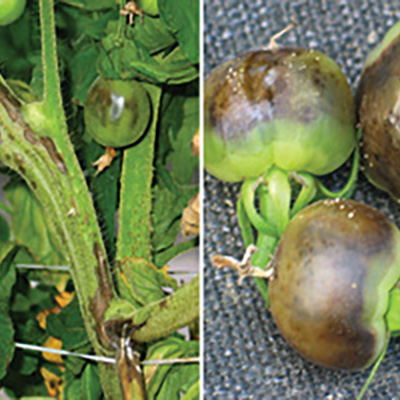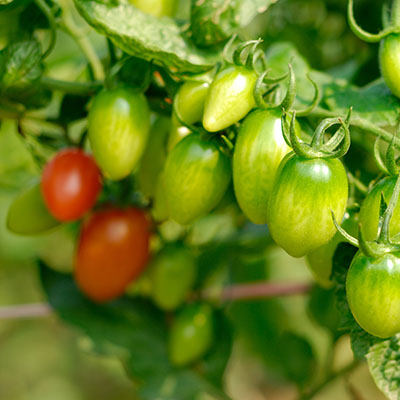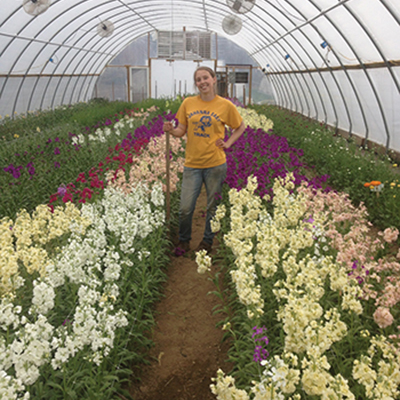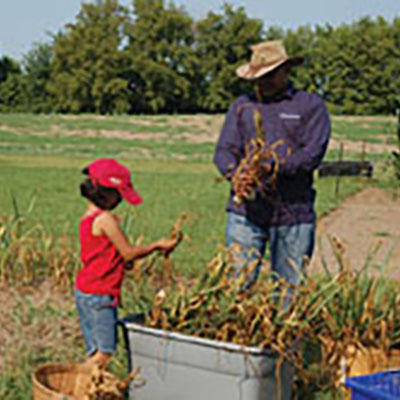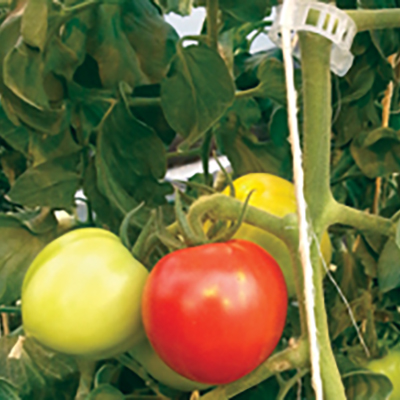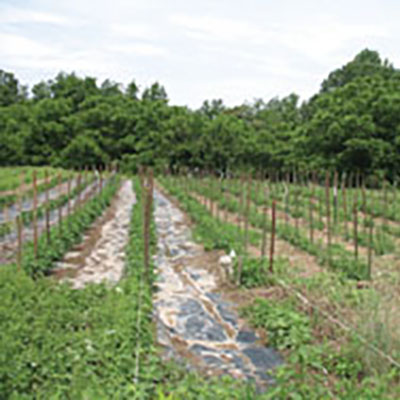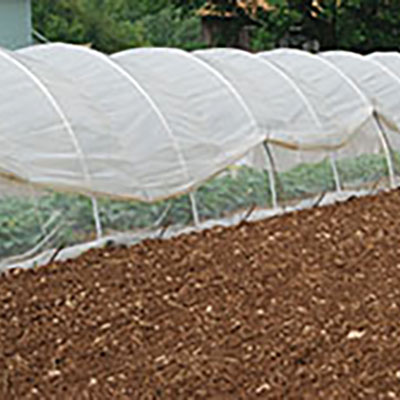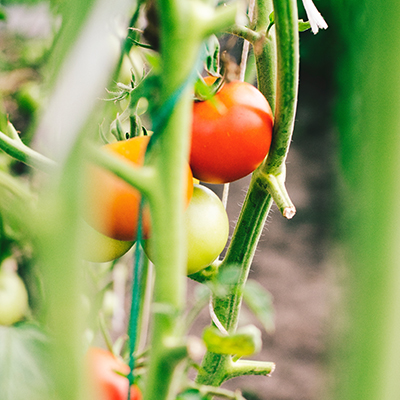By Jesse Frost
Hands down, my number one enemy over the last two seasons has been early blight on my tomatoes. Two years ago this fungal pathogen destroyed nearly an entire quarter acre of main season tomatoes. Last year on my new farm, it tried to do the same.
With the 2018 tomato season quickly approaching, I wanted to better understand the pathogen I was dealing with. Last year I found myself using some OMRI-certified copper fungicide. I picked off infected leaves the second I found them. I wore rubber gloves and sanitized my hands while harvesting. It all worked, but it was not easy. The amount of time I spent nurturing those tomatoes reduced their profitability considerably (along with my morale). So to hopefully avoid all that this year, I called up Dr. Meg McGrath, an Associate Professor of plant pathology at Cornell University to get information about how early blight works. And I learned a lot.
What early blight is
Early blight is two different pathogenic fungi—Alternaria solani and Alternaria tomatophilia—that can affect tomatoes and potatoes. The name early blight, however, is a bit of a misnomer as this pathogen can happen any time during the growing season. Though in many areas the conditions are best for its proliferation in the spring, thus the “early” part of its name.
Why I’m so susceptible
Most fungal diseases like early blight have a preferred set of conditions which they like. And unfortunately, the conditions early blight prefers read like a description of the average tomato planting season where I live here in Kentucky: frequent rainfall, high humidity, heavy dews, cool nights, with daytime temperatures between 60 to 80 degrees Fahrenheit. Early blight thrives under these conditions, which may be part of—though notably not all of—why I have had issues with early blight on two different farms in the state.
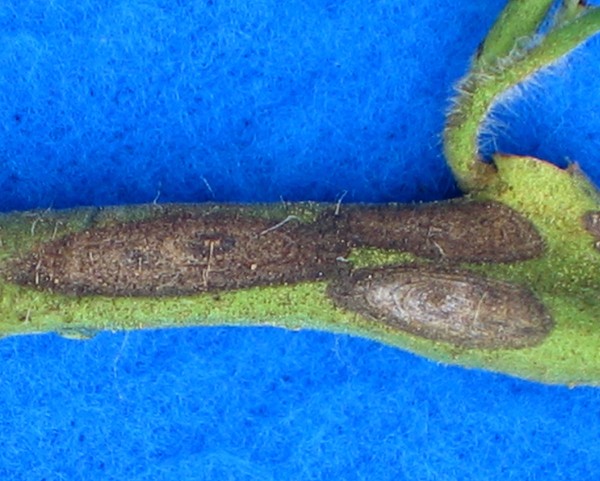
How it travels
Dr. McGrath says that the spores of early blight are not generally the issue in the spring—at least not at first. The spores are how the disease spreads, but not likely how it starts.
“Your very first appearance of early blight on the farm is going to get there either from seed or if you buy plants you can bring it in from somebody else,” said McGrath.
So if you (or your neighbor) bring in infected plants, it’s an easy genesis for the disease. However, the possibility of a seedborne pathogen prompted me to think about my own practices more.
I do have a few tomato seeds that I save every year. McGrath told me that not only can early blight survive on the outside of the seed—which I figured—but on the inside as well, which I didn’t know. It can inhabit the seed itself. The typical fermentation one does to remove the gel sack does nothing to deter the fungus, says McGrath. Instead, you have to “hot water treat” or “steam treat” the seeds—that is, keep the seeds at around 122 degrees Fahrenheit for 25 minutes—something I was not doing with my heirloom seeds.
In the January 2015 GFM article How & why to treat seeds with hot water, Chris Blanchard described the process as, “analogous to the functioning of a fever—you heat the seed as much as you can to kill the disease, but not so much that you kill the seed.” Hot water treatments can kill early blight but keep the seed viable. It’s possible my own seeds had blight and I didn’t see it on the plants when I saved the seed.
I heard back from several seed companies, including Fedco and High Mowing, who confirmed that commercially available tomato seeds are not routinely hot water treated because they focus on prevention, trying to keep seed crops free of alternaria in the first place. “Commercial seed companies are very careful about where they place seed productions, specifically to avoid disease pressure,” said Quality Assurance Manager at Johnny’s Selected Seeds Bonita Nicolas.
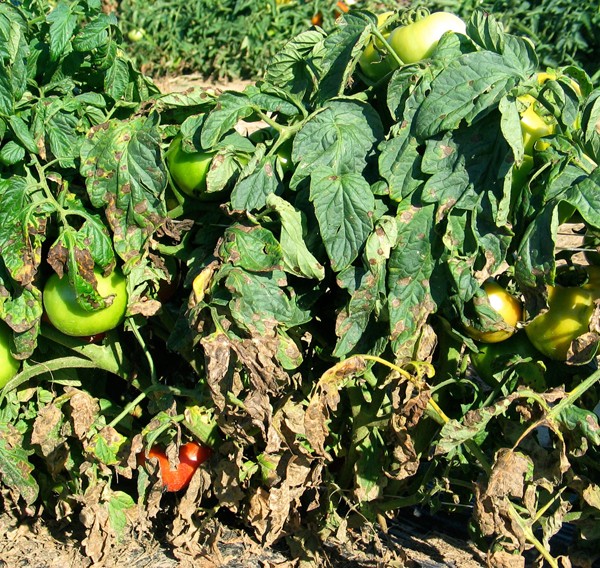
The other reason tomato seed lots are not routinely hot water treated is because hot water treatment can shorten the shelf life and/or lower the germination percentage of the treated seed. Though if you have produced your own tomato seed from plants that had alternaria, hot water treatment may be a way to keep the pathogen from going on to the next generation.
Worth mentioning is that the infected seed element isn’t just confined to what you intend to plant. If you have volunteer tomato plants around the farm from infected seed, they can likewise spread the disease. And I would be lying if I said my household compost pile doesn’t grow some mean tomato plants every year.
Plant tissue
McGrath does offer an important third way for contracting the disease beyond seed and spore. Early blight “survives in the plant tissue as long as the tissue is intact,” says McGrath. “So once it fully breaks down, the pathogen has lost its place to hang out.“
“You usually rototill or disk plant tissue back into the ground at the end of the season, and you put the pathogen there. Now it’s just a matter of it being splashed or dispersed up onto the plant the next season,” she said. So if the plant matter hasn’t fully broken down by the time you replant, you run the risk of re-infecting the farm.
This points to yet another reason why crop rotation is important, but also highlights the significance of managing the crop residue better. Often, I leave a lot of my tomato cleanup for a late winter project and now I’m wondering if it wouldn’t be safer to immediately remove the residue after the last harvest. McGrath suspects the root balls don’t contain the pathogen, as it’s a foliar disease and won’t survive alone below the surface.
Sporulation
Although spores are not the most likely way you will first contract the disease, it is the way that it spreads. “If you look early in the morning,” says McGrath, “you may see a little bit of fuzziness to the leaf spots. And that would be the spores.”
But these spores, McGrath tells me, are not quite as mobile as one may think. “A big wind storm could maybe move them some distance,” she says, “but they are relatively large spores. They are much bigger spores than powdery mildew or downy mildew. Those pathogens can get up in the wind currents and get moved long distances. So it’s like a little sports car [for powdery mildew] versus a tank [for early blight].”
Early blight spores are also not going to stay viable over the winter, she says. As noted above, the disease lives on plant tissue, and that’s where it usually starts. The spores, unless brought in from a neighboring farm, come after the disease has established itself.
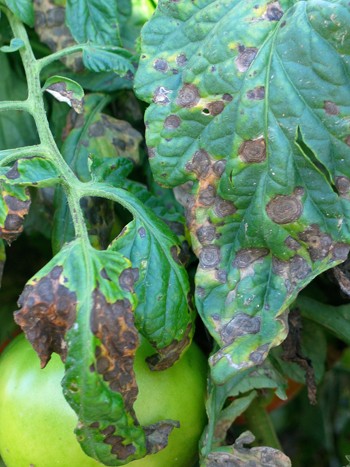
Preventing early blight
The first line of defense against pathogens is to grow resistant varieties, which McGrath says are fairly newly discovered for early blight. And there aren’t that many.
Mountain Magic is a famously late blight resistant variety, and it is also early blight resistant. Valentine, Plum Regal, and Juliet – which are Roma/plum/paste types – are resistant. But slicing tomatoes are more limited. Defiant, a determinate medium slicer, is resistant to early blight. If you have a problem with early blight, or the right conditions for it, it is worth keeping an eye on the disease resistances listed in seed catalogs.
However, it is a common misconception—one of which I was guilty until reading Andrew Mefferd’s section on grafting in The Greenhoouse and Hoophouse Grower’s Handbook—that grafting plants will impart foliar resistance from the rootstock to the scion. As Mefferd points out, this is false. Grafting to early blight resistant rootstock does not defend the scion—the fruiting half—from foliar diseases.
While grafting has been shown to improve the productivity of a plant, it can only impart resistance to the soilborne diseases, which early blight is not. So if the scion (top) does not itself have the resistance, no amount of grafting will stop early blight, late blight, or any other foliar pathogens.
How does resistance work? Dr. McGrath explained that resistant varieties are plants that are capable not only of defending themselves, but simply recognizing the pathogen in the first place. Early blight, in many cases, either does not get detected at all, or it can even turn off the detection capabilities in the genetics of the plant. This, of course, won’t help me to prevent the disease, but it certainly helped me to understand why disease resistant varieties are so important: if a plant can’t detect the disease, that only leaves the farmer to fight it.
Fighting early blight
“Sanitation,” says McGrath, “is much more important with bacterial diseases.” For early blight, it’s about the above preventions and then, if early blight is contracted, it’s about limiting the spread.
Identifying it, however, is key. If you misidentify the disease you may mistreat it. And early blight, says McGrath, is commonly confused with tomato spotted wilt virus. In the case where the farmer misidentifies this virus as early blight, “A fungicide is going to do nothing.”
“They often describe early blight as target-shaped or ring spots, and they’re much more pronounced with tomato spotted wilt virus. So I could see where someone would see these spots and there’s definite target shape to them and go, ‘Oh it must be early blight.’”
The only way to know for sure is to have the tissue sampled. But generally early blight presents itself with brown or yellow rings that first show up on the lower leaves, though you may also see lesions on the stem. You should be able to see the fuzzy sporulation (described above) in the rings in the mornings. That is a good identifier. You may also see spots on the fruit later in the season.
“With a lot of the diseases,” says McGrath, “it’s plant stress that really starts bringing them on. And that’s going to be fruit production. When plants start to produce fruit they are physiologically stressed. That’s the time you’re going to start seeing some of these diseases taking off.”
To control, copper fungicide helps, though it must be spread evenly and thoroughly over the plant. However, more than anything, says McGrath, is keeping the leaves dry—so no overhead watering. Mulch can help, too, to keep the fungus from being splashed onto the plant from the soil. The right conditions are important as the seedling is growing and once it enters the soil, as stress brings early blight on. And then, of course, diligence in watching for developing spots is necessary, especially if you’ve had trouble with the disease on your farm in the past.
Being one of those farmers who has had trouble in the past, I’m hoping this new insight will help get me through this season with less time spent fighting early blight and more time spent harvesting tomatoes. That’s the kind of labor I’m happy to have more of.
Jesse Frost is a vegetable grower and freelance journalist in central Kentucky. He has written for The Atlantic, Civil Eats, Modern Farmer, Hobby Farms and others.

